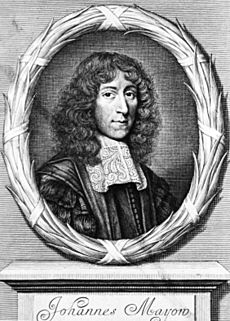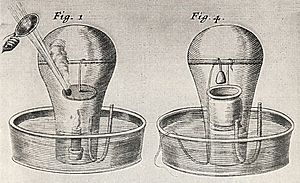John Mayow facts for kids
Quick facts for kids
John Mayow
|
|
|---|---|

John Mayow
|
|
| Born | 1641 |
| Died | 1679 London
|
| Known for | pneumatic chemistry |
| Scientific career | |
| Fields | chemistry |
John Mayow (1641–1679) was a smart scientist from England. He was a chemist, doctor, and expert in how living things work. He is famous for his early studies on breathing and what air is made of. Mayow worked in a field called "pneumatic chemistry," which means studying gases.
Contents
A Scientist's Life
John Mayow was born in 1641, likely near Morval in Cornwall, England. When he was 17, in 1658, he started studying at Wadham College, Oxford. A year later, he became a scholar at Oxford. In 1660, he was chosen for a special fellowship at All Souls.
Mayow studied law and earned degrees in 1665 and 1670. However, he chose to work as a doctor. He became well-known for his medical practice, especially during the summer in the city of Bath. In 1678, he became a member of the Royal Society, a famous group of scientists. He died in London in 1679.
Discoveries About Air and Life
Mayow made important discoveries about air. He found that air has two main parts: one that is active and one that is not. In 1668, he published two papers about breathing and a bone disease called rickets. In 1674, he reprinted these papers, making the one on breathing bigger and better. He added three more papers to this collection. This book was very popular and was translated into many languages.
Air and Burning
Other scientists, like Robert Boyle, had shown that air is needed for things to burn. Mayow took this idea further. He showed that fire doesn't use all the air. Instead, it uses only a very active part of it. He called this active part "spiritus igneo-aereus," which means "fiery-airy spirit." Sometimes he called it "nitro-aereus."
Mayow believed this "spirit" was also found in a substance called nitre (which we now call potassium nitrate). He observed that when antimony was heated strongly with a burning glass, it became heavier. He realized this extra weight came from the "spiritus igneo-aereus" particles combining with the antimony. This was a big step in understanding how things burn.
Air and Breathing
Mayow also thought that the same active particles were used when animals breathe. He did an experiment where he put a small animal and a lit candle in a closed jar. The candle went out first, and then the animal died. But if there was no candle, the animal lived twice as long.
He concluded that this part of the air is absolutely needed for life. He thought that the lungs take this active part from the air and pass it into the blood. He also believed it was needed for all muscle movements. He even thought that the heart, which is a muscle, stops beating when breathing stops because it needs this "spirit."
Heat and Movement
Mayow also suggested that body heat comes from these "nitro-aerial" particles mixing with other particles in the blood. He thought that during strong exercise, even more heat is made when these particles combine in the muscles.
Mayow's ideas were very advanced for his time. He described how breathing works in the body very well. He realized that a special part of the air, which he called "spiritus nitro-aereus," was like what we now call oxygen. This was a century before other famous scientists like Joseph Priestley and Antoine Lavoisier discovered oxygen.
Mayow understood that this "spirit" was important for burning and for making metals heavier when they oxidized. He disagreed with old ideas that breathing was just to cool the heart or move blood. Instead, he saw breathing as a way to bring oxygen into the body. This oxygen was then used to create heat and help muscles move. He even had a vague idea that breathing out was a way for the body to get rid of waste. Using glass jars over water, Mayow showed that the active substance (oxygen) makes up about one-fifth of the air.
Mayow's work showed amazing insights into air and how things burn. He noticed that some materials get heavier when heated strongly. Later, scientists like Antoine Lavoisier explained this as a reaction with oxygen in the air.
Honours
- Fellow of the Royal Society (1678)
See also
 In Spanish: John Mayow para niños
In Spanish: John Mayow para niños


